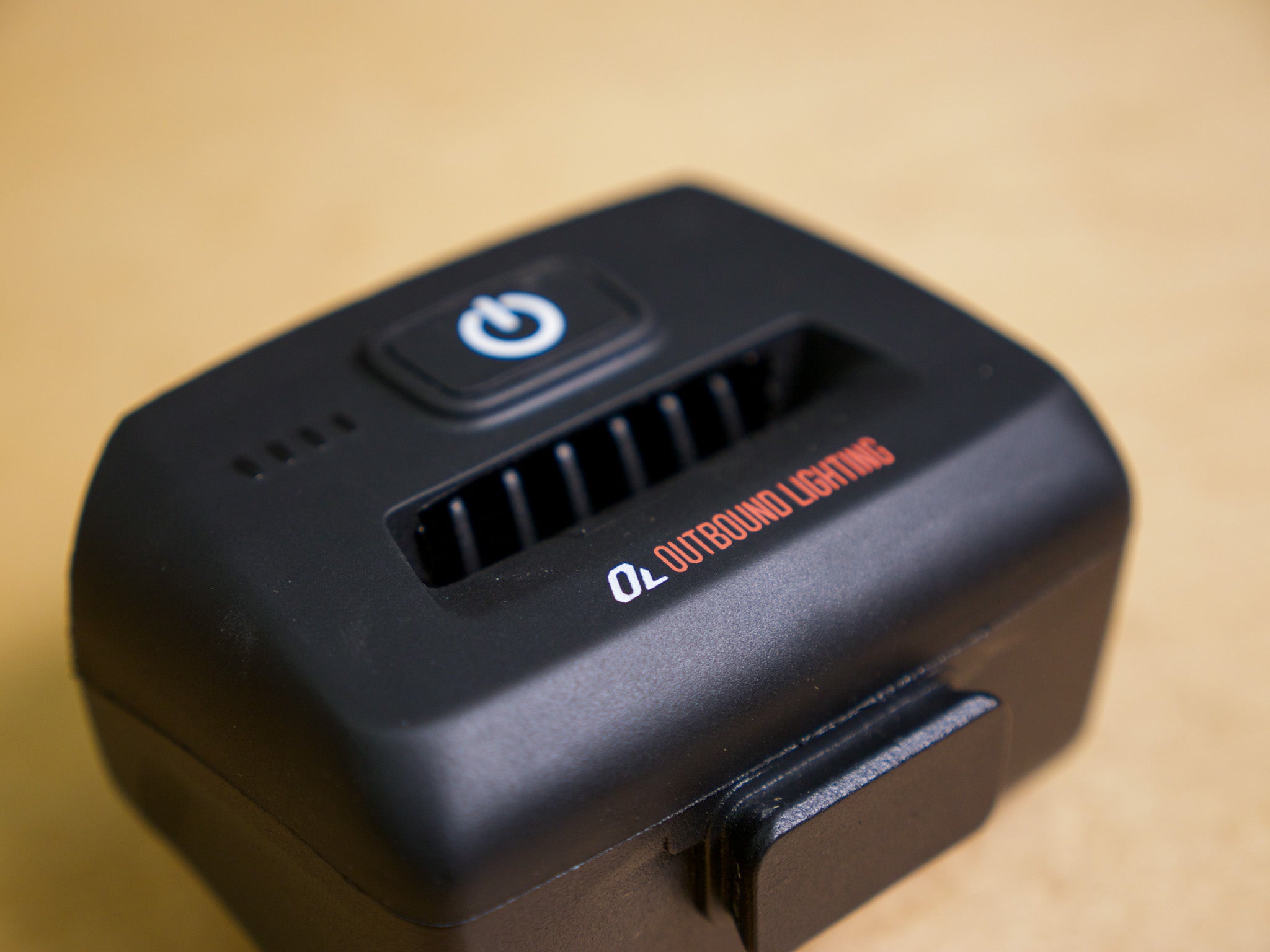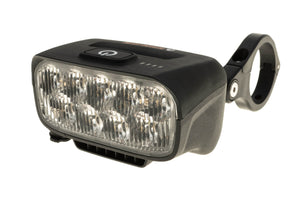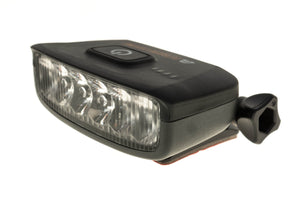As a newcomer to night riding, the thought of flying over roots and rocks in a pitch-black forest always made me uneasy. Fears of finding myself laying in the darkness as my lights bounce wildly off into the woods filled my head. Riding at night always seemed like a poor compromise. Sure I’d be riding my bike, but would the ride quality be the same?
 The powerful duo of Outbound’s Trail Evo and Hangover illuminates the horizon. Photo: Galen Koon
The powerful duo of Outbound’s Trail Evo and Hangover illuminates the horizon. Photo: Galen Koon
My fears were quickly quelled by using a combination of Outbound’s Trail Evo handlebar light and their Hangover helmet light. With a fully self-contained design and simple user interface, the Outbound products made the transition to night riding seamless, and I soon found myself close to matching my usual daytime speeds. After my first ride, I was excited at the opportunity to increase my winter-time mileage.
Who is Outbound?
Since their humble beginning in a suburban basement, Outbound has set out to create the mountain bikers’ ideal bike light. Outbound engineers have combined their experience gained in the automotive and LED lighting industries with their passion for cycling to fulfill their self-proclaimed, “obsession with chasing optical illumination perfection”. While most lights on the market rely heavily on their lumen count to market themselves, Outbound has chosen a more rounded approach.
 Having considered the unique demands of mountain biking, Outbound has designed one of the most well-rounded lights on the market. The Trail Evo even features pass-through cooling, utilizing an integrated air scoop to prevent the unit from overheating.
Having considered the unique demands of mountain biking, Outbound has designed one of the most well-rounded lights on the market. The Trail Evo even features pass-through cooling, utilizing an integrated air scoop to prevent the unit from overheating.
Outbound believes that there is much more to developing a bike light than overall lumen count. They have even gone as far as to say, “We don’t care to try and be the ‘best’ in any specific category because doing that compromises other criteria that are important for a high performing bike light.” Aspects such as beam pattern, runtime, battery life, and cooling all combine to create a well-rounded light. While “GenericBikeLight 2,500” may advertise a higher lumen count than Outbound, it’s important to consider how those lumens are being used. Many high-lumen lights create a “cone” of light that focuses directly ahead, resulting in a spotlight that illuminates a tight area while creating a narrow line of sight and harsh peripheral contrast. Additionally, these advertised lumen counts are often misleading, as they are only maintained for a short period before tapering back to a more sustainable lumen count. Instead, Outbound has created a pairing of lights that flood the trail with light while maintaining their advertised lumen count throughout a ride.
User Interface/Runtime
One of the standout features of these lights is their self-contained design. There’s no fussing with cables and battery packs, as both the Trail Evo and Hangover are single-piece units. Their design limits any clutter when mounted, creating a sleek appearance and hassle-free setup. This also makes charging straightforward, simply removing the units from their mounts and plugging them into their USB-C charging cable. Outbound also supports pass-through charging, allowing for on-the-go charging via an aftermarket USB external battery if desired.
 The self-contained design and simple user interface make using these lights hassle-free, even with winter gloves on.
The self-contained design and simple user interface make using these lights hassle-free, even with winter gloves on.
The Trail Evo and Hangover are as simple as they are effective. With only a single large button, operating the light is easy, even with the thickest winter gloves on. Toggling between the “Adaptive”, High, Medium, and Low modes requires a single press of the button, and holding the button will power the unit on and off.
 Featuring a high, medium, low, and “adaptive” setting, there is a light mode for any scenario.
Featuring a high, medium, low, and “adaptive” setting, there is a light mode for any scenario.
With the Trail Evo, users can expect nearly an hour-and-a-half of runtime on the high setting, three-and-a-half hours on medium, and over four hours on low. The “adaptive” setting starts at the brightest mode and tapers off throughout a ride, allowing for one’s eyes to adjust gradually for its two-and-a-half-hour run time.
The Hangover has an expected runtime of an hour on high, two-and-a-half hours on medium, and over three hours on low. The “adaptive” mode tapers over a two-hour span. Both units conclude with Outbound’s “Get Home Mode,” where output is majorly reduced for the final 20 minutes of runtime to allow a chance to make it off the mountain. When the battery is about to die the light flashes for 15 seconds to allow a chance to slow down and stop, preventing an abrupt loss of light that could cause a crash.
Trail EVO
Named after Galbraith’s iconic Evolution trail, Outbound’s Trail Evo menacingly hangs from its handlebar mount, turning my bike into the cycling equivalent of a Baja 1000 Trophy Truck. Adjustable to fit both 31.8mm and 35mm bars, the mount is solid and holds the light centered in front of the stem. With approximately 2100-2200 lumens, the Trail Evo is seriously bright.
 Simplistic but menacing, the Trail Evo is a sleek addition to any mountain bike.
Simplistic but menacing, the Trail Evo is a sleek addition to any mountain bike.
Instead of the typical “tunnel” of bright light, the Trail Evo floods light onto the trail and the surrounding area. It feels less like riding with a flashlight mounted to the handlebars and more like riding in a well-lit room that travels down the trail in unison with the rider. This sensation is thanks to the Trail Evo’s wide beam profile that can easily illuminate the full width of a fire road, let alone a single-track trail.
 Even on its own, the Trail Evo easily illuminates the trail ahead. Photo by Galen Koon.
Even on its own, the Trail Evo easily illuminates the trail ahead. Photo by Galen Koon.
Hangover
The Hangover has a slim profile and delivers approximately 900-1,000 lumens that create a strong spotlight. Unlike its Trail Evo counterpart, the Hangover is designed with a concentrated beam profile that illuminates far down the trail. Designed as a helmet-specific light, when set up properly, it tracks simultaneously with a rider’s line of sight. The slim profile and low weight of the Hangover allow the light to sit closer to the helmet, lowering its center of gravity and limiting helmet bobble. These characteristics make for a helmet light that is barely noticeable when mounted, a con of many other lights.
 The Hangover is a purpose-built helmet light that provides vision far down the trail.
The Hangover is a purpose-built helmet light that provides vision far down the trail.
The Hangover unit comes with a GoPro style mount with an adhesive 3M backing. Unfortunately, the adhesive mount was incompatible with my helmet due to the placement of the air vents. I was able to work around this issue with an aftermarket action camera strap-mount that firmly held the light in place and can be swapped to other helmets easily.
 I encountered some compatibility issues between the adhesive 3M mount provided and the air vents on my helmet. I was able to work around this issue with an aftermarket action camera strap-mount.
I encountered some compatibility issues between the adhesive 3M mount provided and the air vents on my helmet. I was able to work around this issue with an aftermarket action camera strap-mount.
Verdict
The wide beam and “flooding” of excess light allowed for a better sense of my surroundings; a valuable commodity when it comes to riding through a pitch-black forest at high speeds. I especially noticed a difference between the Trail Evo and other lights my friends use when it comes to its ability to illuminate the edges of the trail and obstacles within twenty feet of the bike’s front tire. While I’m not focusing on my peripheral version while riding, having these areas well-lit gave me a better sense of speed and positioning on the trail, ultimately improving my ride quality.
 The Trail Evo floods the immediate trail and surroundings with light, while the Hangover provides vision far down the trail. Photo by Galen Koon.
The Trail Evo floods the immediate trail and surroundings with light, while the Hangover provides vision far down the trail. Photo by Galen Koon.
I was never caught off guard by a stray root or rock, as the Hangover enabled me to identify and prepare for features well in advance. Once I had the angle of my helmet mount dialed in, the beam of the Hangover and my line of sight were in perfect unison, allowing me to easily see and comprehend any aspect of the trail at speed. I also found this clear line-of-sight to be extremely helpful when off of the bike for trailside maintenance, talking with buddies at a trailhead, or unloading my bike in a dark parking lot.
I never felt restrained by the runtime of the lights, especially for meandering up fire road climbs then ripping back down the hill. I found I could efficiently toggle between modes to maximize the battery life. Setting the lights to the low mode on the way up was plenty of light for slower pedals and even the occasional tech move. Once at the top I would switch both units to high for the best performance possible on the descent. I never came close to draining the battery on my usual two-hour rides.
 There is no questioning if others will see you coming when using a combination of Outbound’s Trail Evo and Hangover. Photo by Galen Koon.
There is no questioning if others will see you coming when using a combination of Outbound’s Trail Evo and Hangover. Photo by Galen Koon.
A set of lights can allow you to ride at night; a quality set of lights can allow you to ride at night at daytime speeds. The combination of Outbound’s Trail Evo and Hangover allowed for just that, and I am now comfortable enough to ride with a similar aggressiveness at night that I would during the day. Outbound has undeniably contributed to sustaining both my weekly miles and sanity during these winter months.
Related Products
More Articles You Might Like
Schwalbe Albert Radial Tire Review // Albert Compared to Magic Mary
Product Reviews / BK Stancil / Nov 26, 2024
The Schwalbe 29 x 2.5 Addix Ultra Soft Albert Trail tire...
Read MoreStumpjumper 15 Vivid Air Review // Stumpjumper 15 Compared to Stumpjumper EVO
Product Reviews / BK Stancil / Nov 15, 2024
I’d summarize the ride quality of the Stumpjumper as Read More
SRAM Eagle GX/X01 Review // The Best Budget Cable Actuated Drivetrain
Product Reviews / BK Stancil / Nov 06, 2024
A combination of Sram Eagle GX and X01 components remain...
Read MoreView More:



